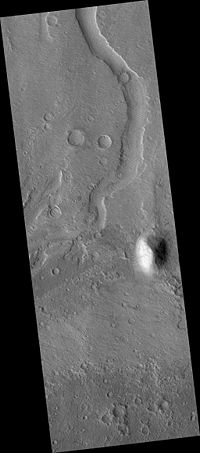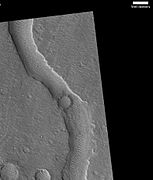
Summary
The Hypanis Valles are a set of channels in a 270 km valley in Xanthe Terra on Mars at 11° N, 314° E, in the Lunae Palus quadrangle. They appear to have been carved by long-lived flowing water, and a significant deposit (interpreted by some to be a river delta) exists at their outlet into the lowlands.[1]
 Proposed (but rejected) Mars Science Laboratory landing site in the Hypanis Valles | |
| Coordinates | 9°36′N 46°42′W / 9.6°N 46.7°W |
|---|---|
| Length | 231.0 km |
| Naming | Classical name for river in Scythia; present Kuban River in Russia. |
The feature was named for a river in Scythia; present Kuban River in Russia.[2]
-
 Map showing location of the Hypanis Valles (indicated with an arrow) and nearby features
Map showing location of the Hypanis Valles (indicated with an arrow) and nearby features
Research described at a Planetary Conference in Texas in the spring of 2018 suggested that the Hypanis Valles fan complex is a delta with multiple channels and lobes, which formed at the margin of a large, standing body of water. That body of water was a northern ocean. This delta is at the dichotomy boundary between the northern lowlands and southern highlands near Chryse Planitia. It is the largest proposed delta system on Mars.[3]
-
A location in the Hypanis Valles, as seen by HiRISE (scale bar is 500 m)
Exploration edit
The Hypanis Valles system was one of the landing sites proposed for the Mars rover Curiosity of the Mars Science Laboratory mission,[1] to assess the past habitability potential of that zone. However, it did not make the final cut.
This location was also one of the four semifinalist candidate landing sites for the ExoMars rover, now renamed the Rosalind Franklin rover mission,[4][5] due to launch in mid- to late 2020s, though it was eventually eliminated from the running. The goal of ExoMars is search for signs of any past or present life on Mars. The proposal was for the rover to land on the distal deposits adjacent to the Hypanis delta and the nearby Sabrina delta. These deposits are likely to be composed of fine grained sediment, having been laid down in a low energy environment, where any potential biosignatures could be preserved.
See also edit
References edit
- ^ a b Sites of Potential Long Term Sub-surface Water, Mineral-rich Environments, and Deposition in South Elysium Planitia, Hellas-Dao Vallis, Isidis Basin, and Xanthe-Hypanis Vallis: Candidate Mars Science Laboratory Landing Sites. L. S. Crumpler.
- ^ "Hypanis Valles". Gazetteer of Planetary Nomenclature. Retrieved 28 April 2019.
- ^ Fawdon, P., et al. 2018. HYPANIS VALLES DELTA: THE LAST HIGH-STAND OF A SEA ON EARLY MARS. 49th Lunar and Planetary Science Conference 2018 (LPI Contrib. No. 2083). 2839.pdf
- ^ The Hypanis fluvial deltaic system in Xanthe Terra: a candidate ExoMars 2018 Rover landing site. Sefton-Nash, E.; Fawdon, P.; Gupta, S.; Balme, M.; Davis, J.; Grindrod, P.; Sidiropoulos, P.; Yershov, V. and Muller, J.-P. (2015). "46th Lunar and Planetary Science Conference, 16-20th March 2015", Houston, TX.
- ^ Recommendation for the Narrowing of ExoMars 2018 Landing Sites. 1 October 2014. ESA.
Further reading edit
- Baker, V.R.; Carr, M.H.; Gulick, V.C.; Williams, C.R. & Marley, M.S. "Channels and Valley Networks". In Kieffer, H.H.; Jakosky, B.M.; Snyder, C.W. & Matthews, M.S. (eds.). Mars. Tucson, AZ: University of Arizona Press.
- Carr, M.H. "Channels, Valleys and Gullies". The Surface of Mars. Cambridge University Press. ISBN 978-0-521-87201-0.




